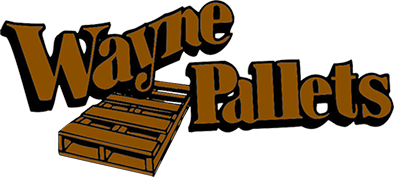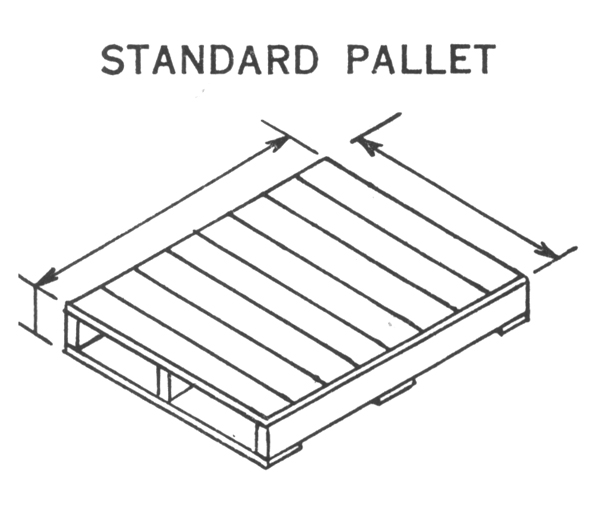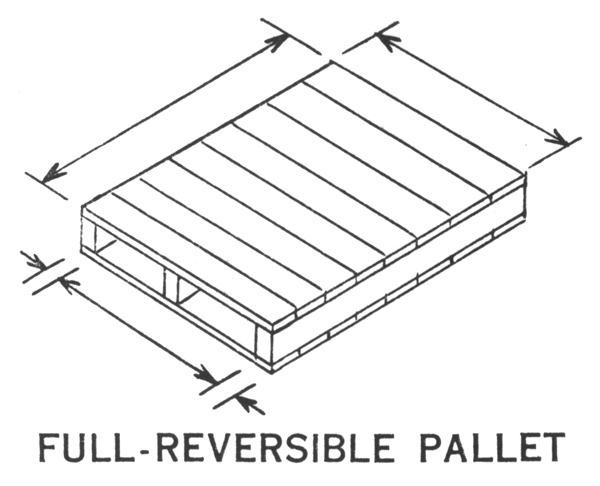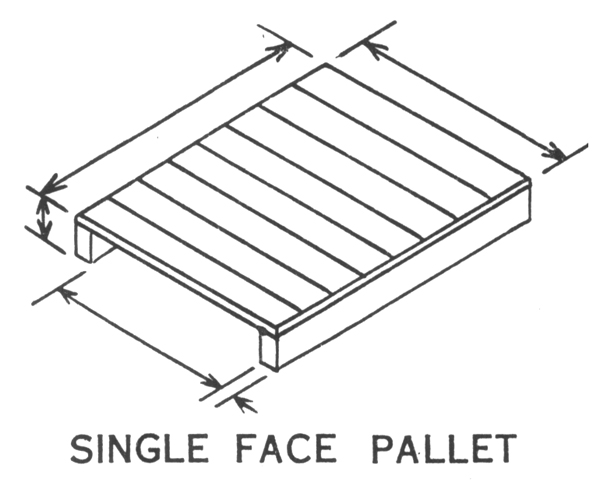All About Pallets
butted deckboard – an inner deckboard placed tightly against an adjacent lead deckboard during pallet assembly to reduce damage to the unit load caused when fork trucks mishandle the pallet
bottom deck – assembly of deckboards comprising the lower, load-bearing surface of the pallet
chamfered deckboard – a deckboard with the edges of one or two faces beveled, either along the full or specified length of board or between the stringers or blocks, facilitating entry of pallet-jack wheels and tines of forklift trucks
deck – top or bottom surface of the pallet, consisting of one or more boards or panels, with or without space between the elements
deck mat – the assembly of deckboards and stringerboards or a solid sheet of material, forming the deck of a block pallet
deckboard – a single element or component of a pallet deck, oriented perpendicular to the stringer or stringerboard
deckboard spacing – the distance between adjacent deckboards
double-deck pallet – a pallet with both top and bottom decks
double-wing pallet – a pallet with top and bottom deckboards or decks extending beyond the edges of the stringers or stringerboards
fastener – a device for connecting pallet components such as nails, staples, screws, bolts, lag bolts, adhesives and welds
four-way block pallet – a pallet with openings at both opposite pallet ends and sides sufficient to admit hand-pallet jacks; full four-way entry pallet
hand (wheel) jack opening – the aperture provided in the pallet bottom deck to allow pallet jack wheels to bear on the ground; window
hardwood – a wood from broad-leaved tree species (not necessarily hard in texture or dense)
inner deckboard – any deckboard located between the end deckboards; interior deckboard
length – refers to the stringer or stringerboard length; also refers to the first dimension given to describe a pallet, i.e, 48″ x 40″, where 48″ is the pallet stringer or stringerboard length
limited use pallet – a pallet designed for an average of up to nine trips, with an average of five handlings per trip in an average environment; single-trip pallet; one-trip pallet; one-way pallet; expendable pallet; shipping pallet
multiple-use pallet – a pallet designed for repeated uses for more than one unit load with an average minimum life-to-first repair of ten trips or more, with an average of five handlings per trip in an average handling environment; multiple-trip pallet; returnable pallet; reusable pallet; warehouse pallet; permanent pallet; general-purpose pallet; special-service pallet; through-transit pallet
non-reversible pallet – a pallet with a dissimilar top and bottom deck configuration or without a bottom deck
notch – filleted cutout in lower portion of the stringer to allow entry for the fork tine, usually 9″ in length and 1-1/4″ to 1-1/2″ in height.
notched stringer – a stringer with two or more notches spaced for fork-tine entry (partial four-way entry)
opening height – the vertical dimension measured between decks, from the floor to the underside of the top deck, or from the floor to the top of the stringer notch
overall height – the vertical dimension measured from the pallet bottom to the pallet top
overhang – the distance the deck or deckboard extends from the outer face of the outer pallet stringer, stringerboard, or block; wing; lip; cantilever; distance the unit load extends beyond the deck
pallet – a portable, horizontal, rigid, composite platform used as a base for assembling, storing, stacking, handling, and transporting goods as a unit load, often equipped with a superstructure
pallet size – overall dimension of a pallet stated in terms of length followed by width and height; for example, a 48″ x 40″ pallet is 48″ long and 40″ wide; has 48″ stringers or stringerboards and 40″ deckboards
pallet life – the period during which the pallet remains useful under given maintenance conditions, expressed in units of time or in the number of one-way movements of the pallet
panel-deck pallet – pallet constructed with composite or structural panel deck or decks
partial four-way stringer pallet – a stringer pallet with notched stringers and block pallet with overlapping bottom stringerboard and deckboards
reversible pallet – a pallet with identical or similar top and bottom decks, to allow either one to support the unit load
single-wing pallet – a pallet with the top deckboards or deck extending beyond the outer edge of the stringers or stringerboards and with the bottom deckboards or deck, if any, flush with the outer edges of the stringers or stringerboards
skid – a pallet without bottom deckboards or deck
slave pallet – rigid pallet or platform; single, thick panel used as a support base for a palletized load in warehouse rack-storage facilities or production systems
softwood – wood from coniferous or needlebearing species of trees (not necessarily soft in texture or of low density)
solid deck pallet – a pallet constructed of a single or multiple components without space between the deckboards or components (see panel deck pallet)
span – the distance between supports
strap slot – recess or cutout in the upper edge of the stringer or the top or bottom pallet deck, designed to allow tie-down of a unit load to the pallet deck with strapping or banding; strap notch; banding notch
stringer – continuous, longitudinal, solid or notched beam-component of the pallet used to support and space the deck components, often identified by location as the outside, interior, or center stringer; bearer; runner
stringerboard – in block pallets, the continuous, solid board member extending for the full length of the pallet, perpendicular to the deckboard and placed between the deckboards and blocks, to serve as Support of deckboards or deck
top-deck of pallet – the assembly of components comprising the upper load-carrying pallet face
two-way entry pallet – a pallet with unnotched solid stringers allowing entry only from the two opposite pallet ends; a pallet without notches in stringers
wing – overhang of deckboard or deck end from the outside edge of the stringer or stringerboard, to increase unit-load area, to add pallet load-bearing capacity, to reduce deckboard-end splitting by fasteners, and to facilitate the lifting of a pallet with bar slings hanging from a crane





